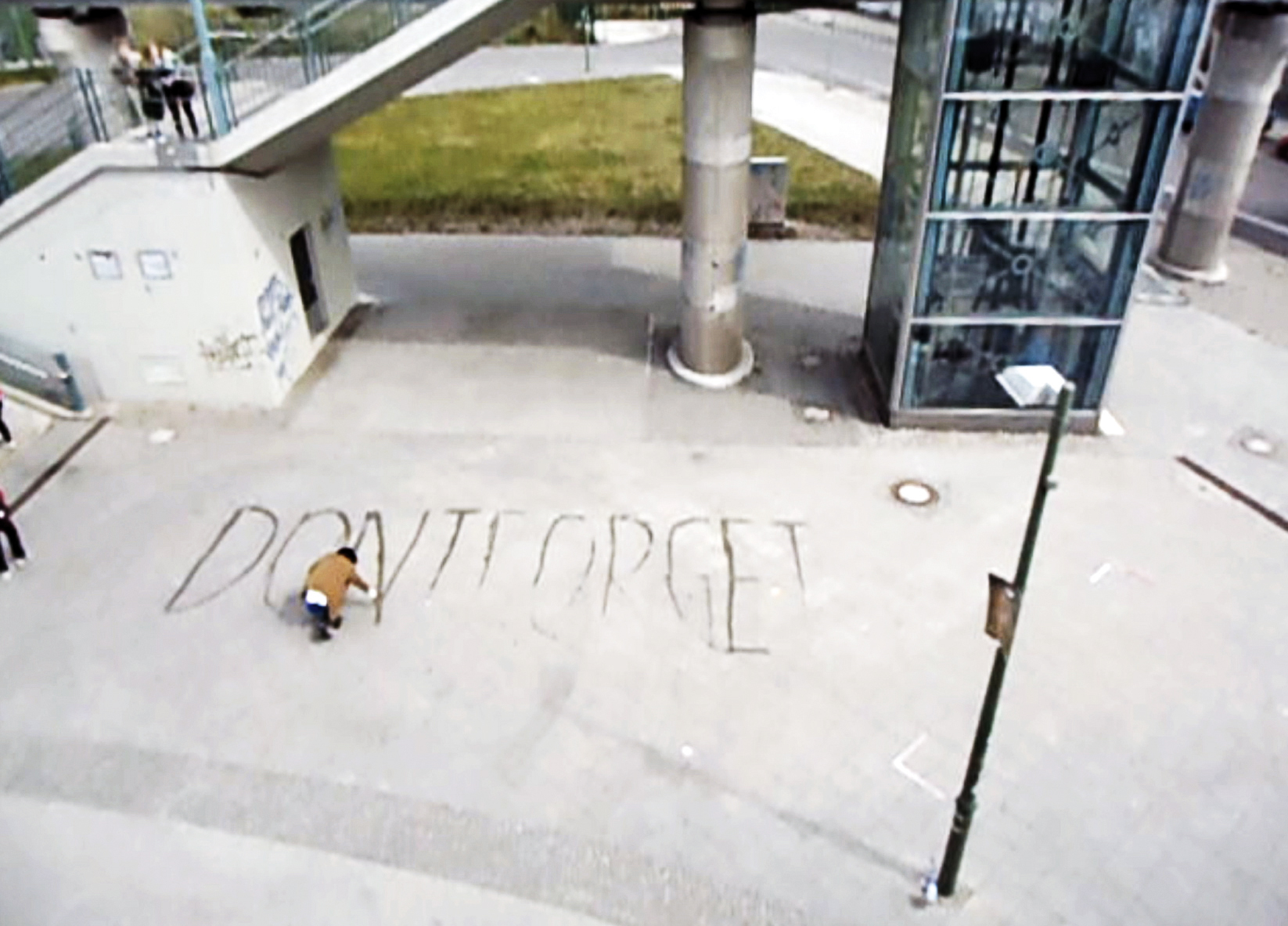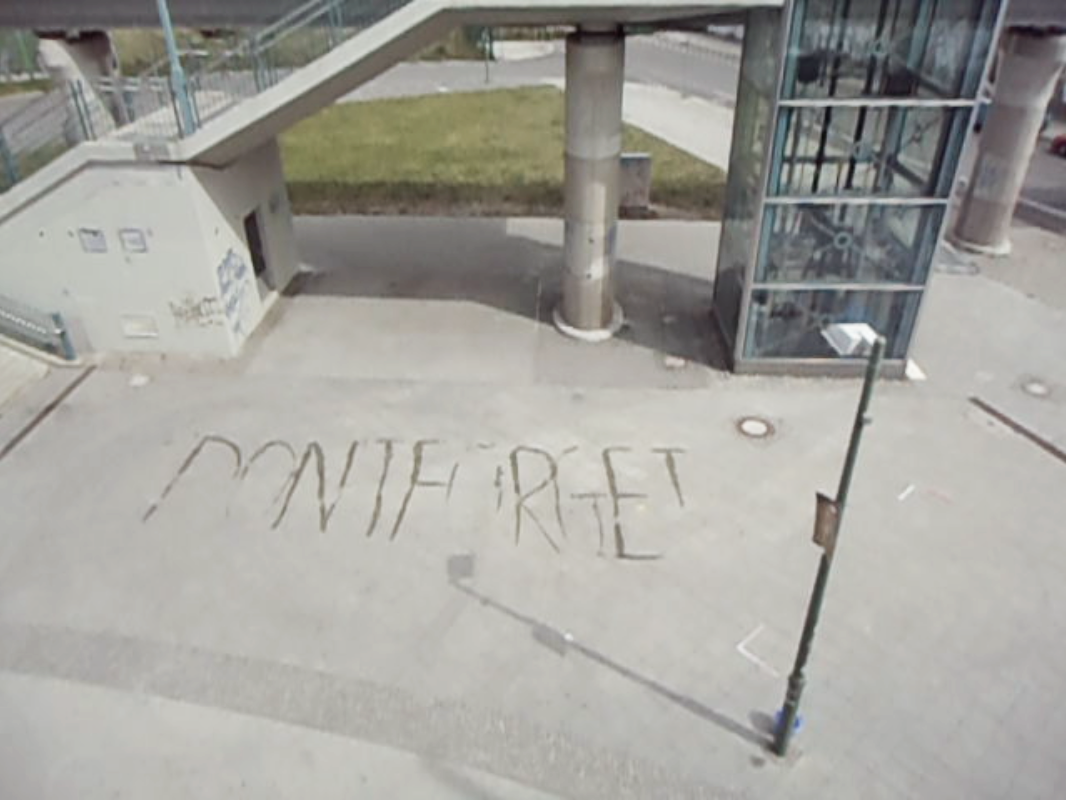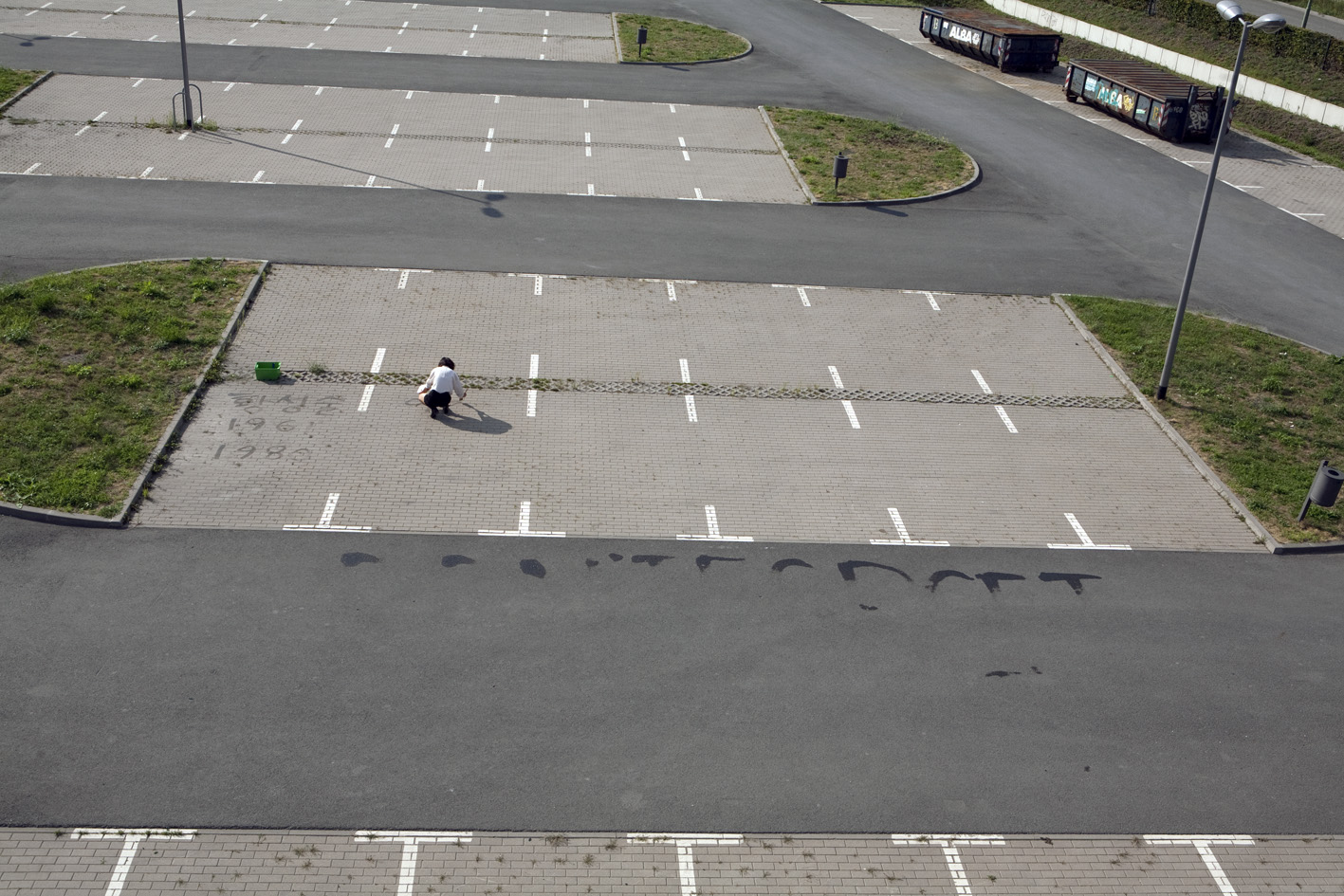FLANEUR
performance / 2012
Berliner Festspiele, Berlin, Germany
Berliner Festspiele, Berlin, Germany
공공장소 퍼포먼스 프로젝트 / 2012
베를리너 극장, 베를린, 독일
베를리너 극장, 베를린, 독일
It is a participatory performance based on my research with influence from Buddhist “walking meditation”, Walter Benjamin’s “Der Wiederkehr des Flaneur” and Michel de Certeau’s “Walking in the city.”
Walking is the most fundamental practice of everyday experience. It transports body from space to space. But do we consider how the human bodies are interconnected with and react on surroundings and situations during this physical movement: walk? This performance following the instruction of Buddhist ‘Walking Meditation, suggests the participants to find out the responce to it. Each step is moved on in calmness with peaceful mind carrying nothing but concentration on merely movement of feet and breath.
︎︎︎
Walking is the most fundamental practice of everyday experience. It transports body from space to space. But do we consider how the human bodies are interconnected with and react on surroundings and situations during this physical movement: walk? This performance following the instruction of Buddhist ‘Walking Meditation, suggests the participants to find out the responce to it. Each step is moved on in calmness with peaceful mind carrying nothing but concentration on merely movement of feet and breath.
︎︎︎
이 참여식 퍼포먼스는 불교의 걷기 명상과 더불어 발터 벤야민의 "방랑자의 귀환"과 미셸 드 샤토의 "도시 걷기"의 영향을받은 내 연구를 기반으로 한다.
걷기는 일상의 가장 기본적인 경험이다.
그것은 장소에서 장소로 몸을 운반한다.
그러나 우리는 이 육체적 움직임, 즉 걷기 동안 인체가 우리를 둘러싸고 있는 환경과 상황에 어떻게 상호 연결되고 반응하는지 생각할까?
불교의 '걷기 명상'의 지시에 따른 이 공연은 참가자들에게 그것에 대한 반응을 찾아 보라고 제안한다. 매번 내딛는 발걸음은 단지 발과 호흡의 움직임에만 집중하는 평화로운 마음으로 평온하게 그들을 이곳에서 저곳으로 이끈다.
오롯이 ‘걷는 나’와 ‘걷기’에 집중하게 될 때까지.
앞으로. 앞으로. 발을 내딛는다.
걷기는 일상의 가장 기본적인 경험이다.
그것은 장소에서 장소로 몸을 운반한다.
그러나 우리는 이 육체적 움직임, 즉 걷기 동안 인체가 우리를 둘러싸고 있는 환경과 상황에 어떻게 상호 연결되고 반응하는지 생각할까?
불교의 '걷기 명상'의 지시에 따른 이 공연은 참가자들에게 그것에 대한 반응을 찾아 보라고 제안한다. 매번 내딛는 발걸음은 단지 발과 호흡의 움직임에만 집중하는 평화로운 마음으로 평온하게 그들을 이곳에서 저곳으로 이끈다.
오롯이 ‘걷는 나’와 ‘걷기’에 집중하게 될 때까지.
앞으로. 앞으로. 발을 내딛는다.
DON’T FORGET :
FIGHT AGAINST OBLIVION
water, brush / 2012 -
on various sites
on various sites
물, 붓 / 2012 -
공공장소 퍼포먼스 프로젝트
공공장소 퍼포먼스 프로젝트




It is an ongoing performance series in the public space motivated from an article in 2010, about Korean president Lee’s absence from the commemoration of Gwangju democratization movement’s the 30th anniversary in Korea.
In terms of psychology, constant repression of memories can occur the social amnesia and it is very often used as a typical strategy for political purposes.
In terms of psychology, constant repression of memories can occur the social amnesia and it is very often used as a typical strategy for political purposes.
2011년부터 연작으로 구성된 <Don’t Forget : Fight Against Oblivion> <잊지마 : 망각에 맞서 싸우라>는 다양한 장소에서 ‘물’로 바닥에 글을 쓰는 행위 예술 작업이다. 여기서 ‘물’은 ‘기억’의 비물질적이고 비정형적이며, 시간에 따라 흐려지고 지워지는 성질을 은유적이며 상징적으로 표현한다. 기억은 이야기와 사실이 공존하는 우리의 ‘삶‘과 ‘역사’의 원천으로써 필멸하는 운명을 가진 생명의 존재를 넘어 선형적 시간의 패턴을 넘나들며 이 세계에 영원히 머문다.
DON’T FORGET :
FORGOTTEN MESSAGE
(18.05.2013)




Since 2007, many of hidden documents and lists of official vitims of Gwangju democ- ratization movement in 1980 in Korea were unveiled to the public. The number of the victims indicated in the lists are 213 that include the reason of death and personal information such as name, year of birth/death. No one would believe this number is correct but merely a part of 1,000 to 2,000 of inofficial victims.
During performance, therefore, I write their names and year of birth and death on each parking spot using as a gravstone with water. It dries out and disappeared and the ground behind me turns back to vacant. But the memories will remain correspondingly when water evaporates in heat, it turns to water vapor which is invisible but still sustains the energy in the air.
During performance, therefore, I write their names and year of birth and death on each parking spot using as a gravstone with water. It dries out and disappeared and the ground behind me turns back to vacant. But the memories will remain correspondingly when water evaporates in heat, it turns to water vapor which is invisible but still sustains the energy in the air.
2007 년부터 1980년 한국의 광주 민주화 운동에 대한 공식적인 피해자 목록과 숨겨진 많은 문서들이 공개되었다. 공개된 목록에 표시된 피해자 수는 사망 사유와 이름, 생년월일 및 사망 년도 등 개인 정보를 포함하는 235명이다. 그러나 아무도이 숫자가 정확하다고 믿지 않는다. 이 숫자는 비공식 피해자 1,000 ~ 2,000 명의 일부에 불과할 뿐이다.
따라서 나는 이 공연을 하는 동안 각 주차 장소를 묘비를 대신하여 그들의 이름과 생년월일을 물로 적는다. 그들의 이름은 마르고 사라지고를 반복하며 내 뒤의 땅은 다시 비어진다. 235명의 이름과 생년월일이 지워지고 나서 다시 빈 공간을 “신원불상”으로 채워나간다. 그러나 물이 열로 증발 할 때 기억은 그에 상응하게 남아있을 것이고, 그것은 보이지 않는 수증기로 변하지만 여전히 공기 중의 에너지를 유지한다.
따라서 나는 이 공연을 하는 동안 각 주차 장소를 묘비를 대신하여 그들의 이름과 생년월일을 물로 적는다. 그들의 이름은 마르고 사라지고를 반복하며 내 뒤의 땅은 다시 비어진다. 235명의 이름과 생년월일이 지워지고 나서 다시 빈 공간을 “신원불상”으로 채워나간다. 그러나 물이 열로 증발 할 때 기억은 그에 상응하게 남아있을 것이고, 그것은 보이지 않는 수증기로 변하지만 여전히 공기 중의 에너지를 유지한다.
DON’T FORGET :
SUNKEN MESSAGE
(16.04.2015)
This repeatition of writing water based letter on the ground, seems like an action in vain, regards to a silent message echoed from the subconscious mind of the public including myself and politicians who get used to forget what shouldn’t be forgotten.
In this context, the performance turns into a format of protest using unlimited-repeatition as a contradictory stategy of collective forgetting and functions as a counter force that fights against general oblivion and social amnesia.
In this context, the performance turns into a format of protest using unlimited-repeatition as a contradictory stategy of collective forgetting and functions as a counter force that fights against general oblivion and social amnesia.
I DREW A CIRCLE
water, brush / 2011
Berlin, Germany
Berlin, Germany
물, 붓 / 2011
공공장소 퍼포먼스 프로젝트
공공장소 퍼포먼스 프로젝트

Front of a Subway station, I draw a circle. Circle as a figure; as a border between people and me; as an Ouroboros; as a dharma wheel; as a repeatition. This water-based circle temporarily functions as a private boundary while staying inside. I walk out of the circle slowly, and people walk on, walk in, walk cross over it. Water turns back into the air, and the stage of my performance returns to a street.
︎︎︎
︎︎︎
지하철 역 앞, 나는 원을 그린다.
형태로써의; 사람과 나 사이의 경계로써;
Ouroboros로써; 윤회 바퀴로써; 반복으로써의 원을.
이 물로 그려진 원은 내가 그 내부에 머무르는 동안 일시적으로 사적인 경계 역할을 한다. 나는 천천히 원을 빠져 나간다. 사람들은 그 안으로, 그 위로, 그 너머로 끊임없이 걷는다. 물은 다시 공기로 돌아가고, 나의 공연 무대는 다시 거리가 된다.
형태로써의; 사람과 나 사이의 경계로써;
Ouroboros로써; 윤회 바퀴로써; 반복으로써의 원을.
이 물로 그려진 원은 내가 그 내부에 머무르는 동안 일시적으로 사적인 경계 역할을 한다. 나는 천천히 원을 빠져 나간다. 사람들은 그 안으로, 그 위로, 그 너머로 끊임없이 걷는다. 물은 다시 공기로 돌아가고, 나의 공연 무대는 다시 거리가 된다.
WHERE DOES THE BOX COME FROM?
cardboard box, acrylic paint / 2011
Berlin, Germany
Berlin, Germany
종이 박스, 아크릴 페인트 / 2011
공공 장소 퍼포먼스 프로젝트
공공 장소 퍼포먼스 프로젝트



An abandoned building, an old ice cream factory in Berlin.
An empty apple box, my first package from Korea.
Rolling on the spreaded paint until it turns into a pink empty box.
No one can recognise where it comes from.
︎︎︎
An empty apple box, my first package from Korea.
Rolling on the spreaded paint until it turns into a pink empty box.
No one can recognise where it comes from.
︎︎︎
버려진 건물, 베를린의 낡은 아이스크림 공장.
빈 사과 상자, 한국에서 온 첫 번째 소포.
빈 상자가 분홍색 이 될 때까지 흩뿌린 페인트 위에 굴린다. 계속. 끊임없이
다시 공간은 비었고, 나는 돌아간다.
그리고 이제 아무도 그것이 어디에서 왔는지 알 수 없다.
빈 사과 상자, 한국에서 온 첫 번째 소포.
빈 상자가 분홍색 이 될 때까지 흩뿌린 페인트 위에 굴린다. 계속. 끊임없이
다시 공간은 비었고, 나는 돌아간다.
그리고 이제 아무도 그것이 어디에서 왔는지 알 수 없다.
© 2025 NAMIA LEIGH
